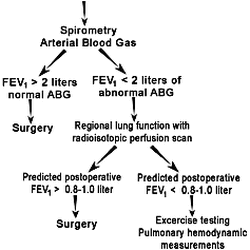Why Does the Sickness of the Patient Matter?
 Doctors use decision trees like this to determine the safety of operations or other treatments.
Doctors use decision trees like this to determine the safety of operations or other treatments.
The lung along with the heart are the major life supporting organs in the body in that they together with the circulatory system deliver vital oxygen to all body tissues. Consequently, if it is necessary to remove part of the lung, it is necessary to ensure enough remaining lung capacity to support quality life. Doctors ask the patient to blow into a machine that measures the amount of lung capacity. These measurements are used to predict complications and patient risk. Sometimes additional tests are used if basic lung function tests are marginal.
We also evaluate heart and other body system reserve to be sure that the patient can withstand treatments including radiation, surgery or chemotherapy.
Perhaps the best predictor of complications is the activity level or performance status of the patient. Patients who spend more than half the day in bed or a chair do poorly with almost any type of therapy.
We also evaluate heart and other body system reserve to be sure that the patient can withstand treatments including radiation, surgery or chemotherapy.
Perhaps the best predictor of complications is the activity level or performance status of the patient. Patients who spend more than half the day in bed or a chair do poorly with almost any type of therapy.